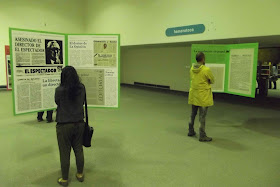The Candelaria's Luis Angel Arango Library, or BLAA, is holding this exhibit about Colombian newspapers' history, which the creators number at the good round number of 223 years.

Colombia, of course, has had a very eventful history, which has been reflected in its newspapers. And the newspapers themselves have been part of that history, for example with the assassination of
El Espectador publisher Guillermo Cano (as well as killings and attacks on many others) and the car bombing of the newspaper's printing plant, both planned by Pablo Escobar. For their part, the media-savvy M-19 'invaded' sympathetic newspapers, to give them a justification for publishing the guerrillas' propaganda. Less dramatically, many journalists from all types of media have been forced into silence or exile by threats.
 |
| The Avianca building in flames in 1973. |

Perhaps paradoxically, and in contrast to the newspaper industry in developed nations, Colombia's dailies are healthy. Despite Bogotá's high poverty rate and illiteracy problem, the city has a half dozen dailies, ranging from
El Tiempo and
El Espectador, to sports sheets and sensationalist tabloids given to featuring gruesome crimes and naked women. Newspapers continue to thrive here thanks in part to the nation's strong economy and to low Internet penetration - altho that will inevitably change - and to the fact that the country's two richest families now own the capital's two leading papers.
For all of their weaknesses and errors, newspapers have played a vital role in informing the public and exposing corruption and misdeeds, and lets hope that they can continue doing, whether on paper or in cyberspace.
 |
| Crowds pay homage to politician Jorge Eliecer Gaitan after his 1948 assassination. |

 Colombia, of course, has had a very eventful history, which has been reflected in its newspapers. And the newspapers themselves have been part of that history, for example with the assassination of El Espectador publisher Guillermo Cano (as well as killings and attacks on many others) and the car bombing of the newspaper's printing plant, both planned by Pablo Escobar. For their part, the media-savvy M-19 'invaded' sympathetic newspapers, to give them a justification for publishing the guerrillas' propaganda. Less dramatically, many journalists from all types of media have been forced into silence or exile by threats.
Colombia, of course, has had a very eventful history, which has been reflected in its newspapers. And the newspapers themselves have been part of that history, for example with the assassination of El Espectador publisher Guillermo Cano (as well as killings and attacks on many others) and the car bombing of the newspaper's printing plant, both planned by Pablo Escobar. For their part, the media-savvy M-19 'invaded' sympathetic newspapers, to give them a justification for publishing the guerrillas' propaganda. Less dramatically, many journalists from all types of media have been forced into silence or exile by threats. 
 Perhaps paradoxically, and in contrast to the newspaper industry in developed nations, Colombia's dailies are healthy. Despite Bogotá's high poverty rate and illiteracy problem, the city has a half dozen dailies, ranging from El Tiempo and El Espectador, to sports sheets and sensationalist tabloids given to featuring gruesome crimes and naked women. Newspapers continue to thrive here thanks in part to the nation's strong economy and to low Internet penetration - altho that will inevitably change - and to the fact that the country's two richest families now own the capital's two leading papers.
Perhaps paradoxically, and in contrast to the newspaper industry in developed nations, Colombia's dailies are healthy. Despite Bogotá's high poverty rate and illiteracy problem, the city has a half dozen dailies, ranging from El Tiempo and El Espectador, to sports sheets and sensationalist tabloids given to featuring gruesome crimes and naked women. Newspapers continue to thrive here thanks in part to the nation's strong economy and to low Internet penetration - altho that will inevitably change - and to the fact that the country's two richest families now own the capital's two leading papers.













No comments:
Post a Comment